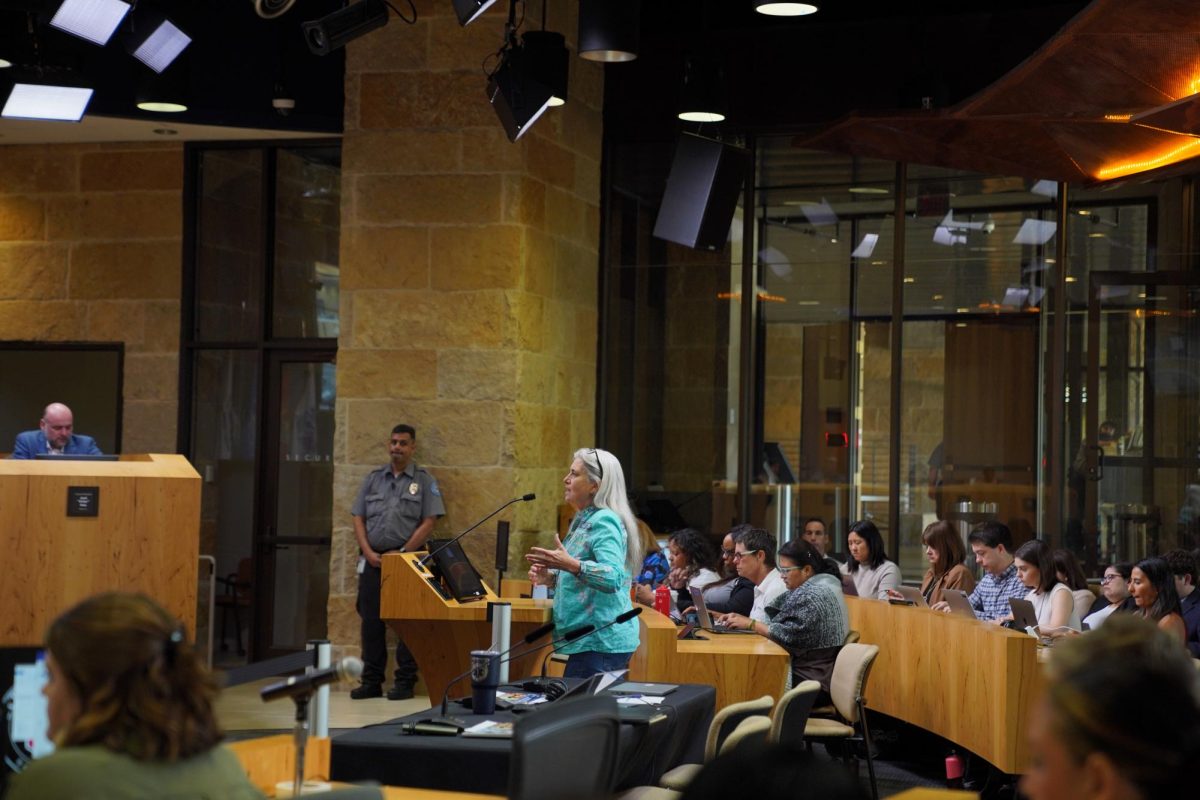The Occupy Wall Street movement, which began in early September in New York City’s Zuccotti Park as a protest against political and economic corruption, has been steadily gaining momentum and has spread throughout the nation and all the way to Europe. The movement finally reached campus with yesterday’s student walkout. Austin’s own demonstration, Occupy Austin, will begin today at City Hall at 10 a.m.
Thousands have said they will attend the protest via the Occupy Austin Facebook page, a number that Lauren Welker, an Occupy Austin spokesperson, called unprecedented considering much of the planning didn’t begin until about two weeks ago. Welker said a core group of about 20 people, with an enormous amount of help from others, used Twitter, Facebook and Livestream — social media tools that have become a staple of protests and revolutions worldwide — to get things moving.
“The idea sparked,” Welker, a geological sciences graduate student, said. “It was like ‘why not?’ It’s not just New York that’s affected by Wall Street; it’s all over the nation. It’s here. Why don’t people go out to the streets and protest what’s going on? We can’t all afford to fly out to New York.”
Occupy Wall Street, now in its third week, has had a few run-ins with the New York Police Department, including a controversial mass arrest of approximately 700 when protesters took to the Brooklyn Bridge and disrupted traffic, according to a report by the Guardian. Welker said that they have been working with Austin police to make sure incidents like that don’t happen.
“We don’t want to break the law,” she said. “That’s not the purpose.”
The purpose of the protests, which have spread from New York City to Los Angeles to Austin and scores of cities in between, is a little harder to pin down, much to the annoyance of people who do not see the purpose. At the movement’s core, Welker said, is the discontent that many Americans share for political and economic corruption on national, state and local levels and the corporate influence that holds sway over many elections and policy decisions.
She said people are angry about how these issues are affecting society and particularly the lives and well-being of those that call themselves ‘the 99 percent’ — people who don’t, according to People for the American Way President Michael B. Keegan in an article for the Huffington Post, have access to 25 percent of the nation’s earned income and 40 percent of its wealth, which is held by 1 percent of the country. Accusations such as these have prompted counter-accusations of ‘anti-capitalism,’ ‘socialism’ and declarations of class warfare from some, especially on the far right, but Welker said that isn’t the case.
“We love America,” Welker said. “That’s one thing I think is really important that everyone should understand. This is a ‘stop screwing us’ movement.”
‘Stop screwing us,’ however broad or vague a charge, hasn’t failed to resonate with those who are taking to the streets. The protesters, Welker said, know that the current situation “needs to change.”
“I would describe [Occupy Wall Street] as an expression of frustration, of unhappiness with political and economic systems,” said journalism professor Bob Jensen. “It’s not simply a critique of an individual politician or an individual CEO. It’s a recognition that our economic and political systems are fundamentally broken.”
For its part, Occupy Austin tried to capture the frustration while being mindful of the diversity of opinions with the group’s mission statement that was presented and passed out at Tuesday evening’s general assembly at City Hall. About 100 Austinites, old and young alike, attended the meeting where protest logistics were worked out. It was the sixth general assembly since last Thursday’s kick-off gathering at Ruta Maya where about 500 people attended. The mission statement reads:
“We stand in solidarity with our brothers and sisters who occupy Wall Street and occupy around the world. We are dedicated to non-violently reclaiming control of our governments from the financial interests that have corrupted them. We demand that our public servants recognize the people are the supreme authority.”
According to the Mission and Values group, one of 30 sub-groups that Occupy Austin is divided into for organization and efficiency’s sake, the aim of the statement was to balance inclusivity with specificity.
“We’re very much about involvement,” Welker said. “It’s important for all the ‘Occupied’ movements across the nation to stand in solidarity. In Austin, we hope to make it look as inviting and inclusive as possible.”
With such a large number of people involved, protesters have had difficulty in coming up with petitions and goals. This conundrum, despite the movement’s intentions, has led to ambiguity — for better or for worse.
On one side, people see the protesters’ amorphous agenda not as a sign of uncertainty but as reflective of a predicament too complicated for any one demand to address. Welker said the name ‘Occupy Wall Street’ says it all — no specifics necessary at this point.
“I think the idea behind the movement is pretty clear,” Welker said. “It didn’t start off as ‘Occupy Central Park’ or ‘Occupy Union Square.’ It’s Occupy Wall Street. In the broad scheme of things, it’s a movement based off of the financial corruption of our government and corporate greed. It’s to get the conversation started. That’s the point — right now, there’s not even a conversation.”
But for many, including some of the organizations and political entities that the protesters are confronting, the lack of specific demands has led to criticism and confusion. There are those who write the Occupy protests off as little more than, as Fox News recently opined, “another disorganized and liberal whinefest.” Others, while not dismissive, are treading cautiously.
Austin City Councilman Chris Riley said that he’s not sure what shape the group’s objectives will take or how events will unfold over the coming days. That’s not to say the city council isn’t paying attention, he clarified. Riley said that people taking part in the democratic process is a good thing.
“I’m interested to see what goals emerge from this process and how the individuals involved plan to achieve those goals,” he said.
Riley’s outlook rings true with many would-be protesters, too. Laurel Sullivan, a local biologist said that she’s interested to see what Occupy Austin’s goals are before she lends her support.
“Political discussions can go on for centuries,” Sullivan said. “And that’s healthy. But for me, to have a protest, it seems there should be goals. I don’t really have time to come march around because I’m pissed off.”
Occupiers sympathize with views like Sullivan’s. After all, they also realize that eventually, they’ll have to answer the “demand for demands,” said Kate Houston, a philosophy senior. Houston, who plans on protesting downtown, said that for now, actually going out and doing something rather than just talking is good enough for her. But without concrete goals, she acknowledged, the movement risks fizzling out, or worse, getting co-opted by someone who could use Occupy Wall Street’s energy for its own gain.
“I’m just worried that the same thing is going to happen that happened with the Tea Party,” Houston said. “Like a mainstream media outlet or political pundits taking over rather than it staying a grassroots movement. I really hope it doesn’t. I guess time will just have to tell.”
Jensen agreed that energy without direction has an expiration date, but that doesn’t mean those who are on the fence about helping should sit back and wait to see what happens.
“If it doesn’t go beyond where it is, yes, it has a limited shelf life,” Jensen said. “But there’s no reason that the people involved in it can’t make decisions about where they want to take it. And that’s not something to predict, that’s something to be part of. It’s better to lend one’s energy.”
Printed on October 6, 2011 as: Austinites rally, 'occupy' City Hall




















